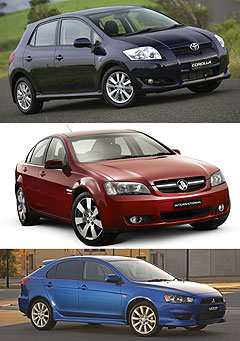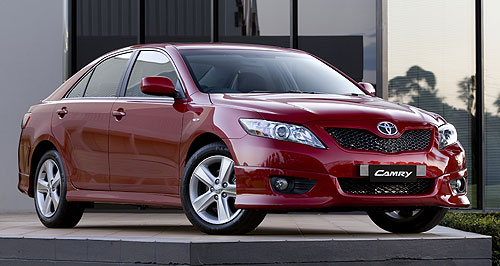News - VFACTS - Sales 2009 - AugustAussie car sector back in businessUp there: Sales of Toyota's upgraded Camry surged 40.8 per cent in August. New-vehicle market steadies as consumer confidence returns3 Sep 2009 By TERRY MARTIN AS ECONOMISTS marvel at how Australia has managed to avoid a recession – and, indeed, grow – in the face of the global financial crisis, the automotive sector has provided further evidence that consumer confidence has returned and that multi-billion-dollar government handouts and tax breaks to households and businesses have had a positive impact on new-vehicle sales. Figures released today by the Federal Chamber of Automotive Industries (FCAI) show the overall August sales result of 73,287 passenger cars, SUVs and commercial vehicles was down 5.2 per cent, or 4036 vehicles, to leave the market down 14.2 per cent (or 100,151 vehicles) after eight months of trading, which is considered an excellent result in light of local and global production cuts and much deeper sales declines overseas. Several segments recorded sales increases – compared with August 2008 – including small cars (up 7.2 per cent), light cars (up 0.3 per cent, or 1.2 per cent sans the niche over-$25,000 bracket), luxury SUVs (up 19.2 per cent), medium-sized SUVs (up 1.6 per cent), commercial vans (up 8.2 per cent) and even sportscars (up 1.4 per cent). The main prestige passenger-car segments also went up, including medium (up 1.8 per cent), large (up 4.2 per cent) and over-$100,000 executive transport (up 27.6 per cent). Year-to-date, 603,843 new vehicles have been sold.  From top: Toyota Corolla, Holden Commodore, Mitsubishi Lancer. From top: Toyota Corolla, Holden Commodore, Mitsubishi Lancer.“These figures indicate that private buyers are regaining confidence and re-entering the market,” said FCAI chief executive Andrew McKellar. “The better-than-expected sales to private buyers and rental companies have really buoyed the market heading into spring. “Strong demand continues from business buyers who are taking advantage of the tax break available, and the effectiveness of the stimulus measure is being reflected in the supply constraints experienced on some models.” The VFACTS figures show that rental passenger car purchases were up 14.3 per cent last month, clotting sales which have haemorrhaged 38.7 per cent YTD in this corner of the market, while overall private and business sales (which includes SUVs and LCVs) were down a respective 1.6 and 4.5 per cent for the month to rest at 13.1/10.8 per cent down YTD. Government sales fell 24.4 per cent for the month, to be 13.5 per cent down YTD, which in turn reflects on the continued decline in Australian-built cars. For the second successive month, the Holden Commodore, with 3329 sales (down 30.8 per cent for the month) was toppled from its usual position as Australia’s most popular car, deferring again to the Toyota Corolla which recorded 3659 sales (down 3.6 per cent). The status quo for this financial year should change before too long with the launch of the updated VE Commodore this month, which could also see a corresponding rise in government sales, continued strength in rentals and an improvement in the large-car segment overall. The latter was down 22.3 per cent last month to be 19.1 down YTD. In percentage terms, Ford Falcon sales were the most impressive, down just 9.6 per cent for the month with 2449 sales (to be 5.5 per cent off YTD, compared to Commodore which is down 12.9 per cent YTD), with the Toyota Aurion down 23 per cent for month with 838 sales (down 36.3 per cent YTD). No longer the one to beat in the medium-sized SUV segment, Ford’s Australian-built Territory was down 9.9 per cent for the month with 896 sales – and is down 26.2 per cent YTD. Toyota’s recently upgraded medium-sized Camry had a strong month, reasserting its dominance with 2192 sales (up 40.8 per cent) to be well ahead of its imported rivals, including the next-best Mazda6 on 694 (up 2.1 per cent), the new Ford Mondeo (357), Honda Accord Euro (345) and the Subaru Liberty (269), which was down 28.1 per cent but is awaiting the arrival of a redesigned model later this month. The Corolla and Camry result has underscored Toyota’s continued superiority in the Australia market, with the Japanese brand recording 15,994 sales for the month, for a 21.8 per cent share. This was down just 1.04 per cent on August 2008 and saw it remain miles ahead of Holden on 9505 sales (13.0 per cent share, down 0.87 for the month), Ford on 7623 (10.4 per cent, down 0.72 per cent) and Hyundai, which again outsold Mazda, on 5980 (8.2 per cent, up 3.46 per cent). Mazda managed 5683 sales for the month, which converts to an 8.0 per cent share (up 0.46 per cent for the month), and continues to hold down fourth position YTD with 50,490 sales (8.4 per cent share) compared to Hyundai in fifth on 42,141 (7.0 per cent). Ford holds down a clear third YTD on 31,862 sales (10.2 per cent), behind Holden on 75,923 (12.6 per cent) and Toyota on 126,891 sales YTD for a 21 per cent share – a massive lead of 50,968 vehicles from its nearest competitor. Toyota Australia’s senior executive director of sales and marketing, David Buttner, said promising signs for both it and the car sector as a whole could be seen in both the VFACTS results and the government’s national accounts, the latter showing that Australia has had the fastest-growing advanced economy in the past year and was the only advanced economy not to record negative growth over the period. “Yesterday’s national accounts figures show the economy, while still posing significant challenges, appears to be gathering pace,” Mr Buttner said. “Our dealers tell us that customer enquiries and forward orders have shown steady signs of improvement in recent months. If this trend continues, we can expect to see more business and private consumers having the confidence to purchase new vehicles over the balance of the year.” Mr Buttner pointed to the fact that three of its models – Corolla, Camry and HiLux – filled the top six positions on the national sales charts last month, and that the brand scored a trifecta with Kluger, Prado and RAV4 being Australia’s best-selling SUVs, each with more than 1000 sales. It also continued to dominate the large-SUV segment with LandCruiser, and the van and light-bus divisions with HiAce. There were standout performers from other brands, and notable efforts from a host of new models. Among the light cars, the Hyundai Getz again led the field with 1868 sales (up 10.8 per cent) – a ready example of why Australia will be the sole world market not to discontinue the Getz once the i20 arrives next year – while Toyota’s Yaris, though still second, was down 26.9 per cent with 1406 sales. Suzuki’s new Alto recorded 96 sales, while Honda’s Jazz/City combination brought a combined 1055 sales. While Corolla dominated the small-car scene, three other models continued their positive runs with more than 2000 sales – the Mazda3 (2898 units, up 7.6 per cent), Mitsubishi Lancer (2171, up 54.6 per cent) and Hyundai i30 (2105, up a massive 145.1 per cent). Holden’s new Cruze was next best with a strong 1971 sales, while at the lower – but still significant – end, Toyota also notched up a further 295 sales with its new-generation Prius (up 27.2 per cent). The Prius result was reflected in the increase in both private and non-private hybrid passenger-car sales, which were up 27.1 and 14.8 per cent respectively – an encouraging sign for Toyota as it prepares to launch its Australian-built Camry hybrid in the coming months. Sales of small cars over $40,000 were up 14 per cent for the month, with Audi leading the segment with its A3 (200 sales, up 100 per cent), well ahead of the Mini Cooper (133, up 66.7 per cent) and the BMW 1 Series (84, down 17.6 per cent). Medium cars over $60,000 were also up (by 1.8 per cent), with the BMW 3 Series outselling the Mercedes C-class with 356 sales to 342 – a 21.5 per cent increase for the BMW, but a 22.1 per cent fall for the Benz – while Audi was a close third with its A4 on 326 (up 6.5 per cent). Mercedes turned the tables in large cars over $70,000 – another segment to record a positive result, up 4.2 per cent – with its E-class winning 181 sales (up 33.1 per cent) to be streets ahead of the BMW 5 Series (71 sales, down 19.3 per cent) and a fast-closing Audi A6 (54 sales, up 42.1 per cent). Among the limos (upper large over $100,000), a 27.6 per cent increase in the segment can be attributed to the BMW 7 Series (34 sales, up 88.9 per cent), Mercedes S-class (27, up 50 per cent), three Rolls-Royce sales and a couple of registrations from Porsche with its all-new Panamera. Among the lacklustre people-mover market segment, Hyundai’s iMax – which last month scored four stars from the ANCAP crash-test regime – added to the South Korean brand’s growth chart with 98 sales to be third behind the well-established Kia Carnival and Toyota Tarago. The same can be said for Hyundai’s iLoad van, which recorded 348 sales (up 109.6 per cent) to be a clear second behind the HiAce (833, up 20.7 per cent). The growth in sportscar sales came from the over-$80,000 division, in which Mercedes won 153 sales, and led the field, with its new E-class Coupe. Audi won 115 A5 new customers (up 101.8 per cent) and Lexus made 20 sales with its 1S250C, while BMW was down 24.9 per cent with its 3 Series Coupe/Convertible (136). Among the SUVs, the RAV4 (1061 sales, up 15.1 per cent) only narrowly outsold the Hyundai Tucson, which racked up 1024 sales – up a phenomenal 283.5 per cent – to be the only other small SUV over 1000 units. Yes, that means it beat the Subaru Forester (952, down 37.9 per cent), Nissan X-Trail (533, down 27.9 per cent) and the Honda CR-V (367, down 42 per cent). In the medium-sized SUV segment, the only other model to match the pace set by Kluger (1108, up 19.8 per cent) and Prado (1065, down 11.2 per cent) was the Holden Captiva (1031, up 59.8 per cent). Meanwhile, in the luxury SUV division, BMW recorded strong results with its X5 (296, up 27.6 per cent) and X3 (90, up 30.4 per cent), while the X6, which is the only model in this segment to be in positive territory YTD, slipped 54.6 per cent for the month with 44 sales. Lexus also returned to form in this segment with 178 RX sales (up 10.6 per cent), while Land Rover found 152 Discovery buyers (up 58.3 per cent). Among the 4x2 utes and one-tonners, Chinese brand Great Wall Motors found 56 and 76 buyers respectively for its new SA220 and V240, while Mitsubishi made further gains with Triton (510, up 6.5 per cent) and Mazda improved with the BT-50 (396, up 32.4 per cent). Having said that, none of these were close to the HiLux or the Ford or Holden car-based utilities, which all cleared at least 800 units. The increasingly important 4x4 segment saw Great Wall accumulate a further 96 units with the V240, while the small-business buyer interest in the market was evident with Holden improving with Colorado (608 units, up 65.7 per cent) and Ford with Ranger (631 units, up 10.5 per cent). The Triton was down 17 per cent for the month (516) but is still the only mainstream 4x4 to be up this year.
 |
Click to shareVFACTS articlesResearch VFACTS Motor industry news |
|||||||||||||||||||||||||||||||||||||||||||||||














Facebook Twitter Instagram